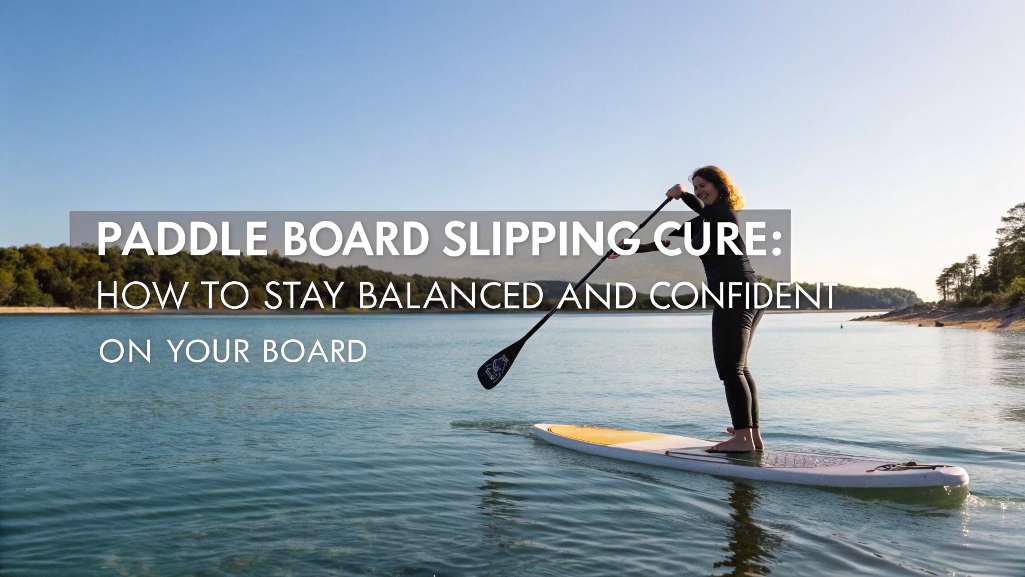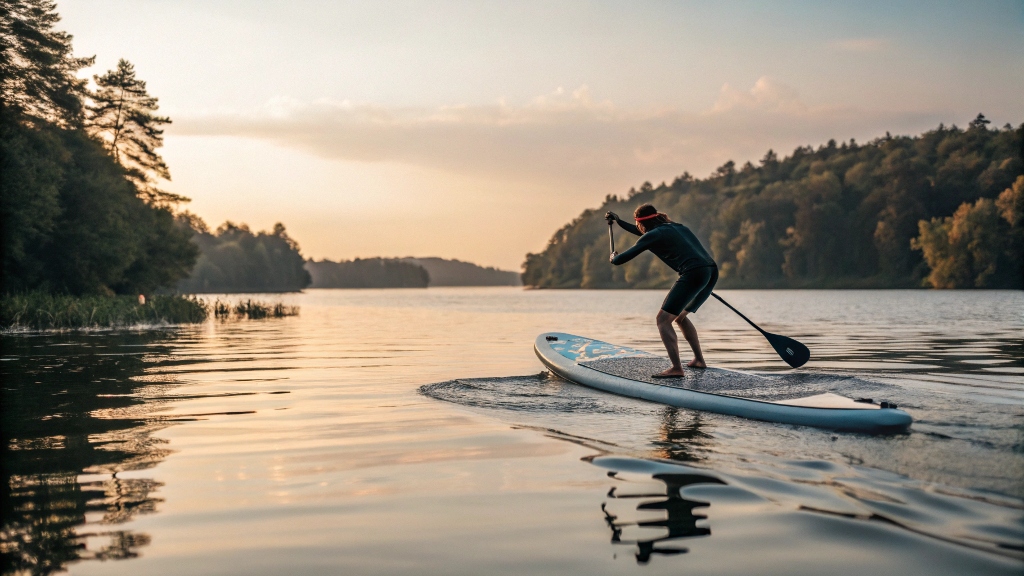Paddle Board Slipping Cure: How to Stay Balanced and Confident on Your Board

Paddle boarding is all about balance, freedom, and fun. But when your feet start slipping, the thrill fades fast. Whether you’re new to the sport or a seasoned paddler, slippery boards can mess with your confidence and safety. That’s why knowing a reliable paddle board slipping cure is essential.
From poor traction pads to worn-out grip tape, several culprits can make your ride unstable. The good news? You can fix it easily with the right tools, techniques, and a few insider tips.
I still remember my first ocean paddle on a rented board. My feet slipped more than they gripped. I fell twice within the first ten minutes. Later, I found out the board’s deck pad had worn out—and no one told me! Since then, I’ve tested tons of gear to fix this issue.
If you’re tired of falling and ready to stand strong, keep reading. In this guide, you’ll learn simple, effective ways to prevent slipping. From wax to traction upgrades, this post has everything you need.
Also, if you’re serious about improving your paddle boarding gear, take a moment to explore Cool Surfing Gear for the best boards, pads, and accessories.

Why Paddle Boards Become Slippery Over Time
Understand What Causes the Problem
Before we jump into solutions, it’s helpful to know why your paddle board becomes slippery in the first place.
Boards lose grip for several reasons:
- Worn-out traction pads: Over time, foam pads flatten and lose their texture.
- Waterlogged pads: Some pads retain water, creating a slick surface.
- Dirt and oils: Sunscreen, sand, and sweat make the surface slippery.
- Lack of grip wax or tape: Without these, bare surfaces offer little friction.
- Cheap materials: Lower-cost boards often use thinner, less durable deck pads.
According to a report from Standup Journal, about 68% of paddlers experience grip-related issues within the first year of board use—especially in hot, sunny regions where UV damage occurs faster.
Most manufacturers don’t talk about this enough. So paddlers are left guessing when problems arise.
Surf energy conditions also affect grip. On choppier days with stronger swells, your stance must be more secure to stay upright. Using tools like the surf energy forecast app can help you prepare for changing wave conditions.
By addressing these issues head-on, you can avoid injuries, frustration, and time wasted in the water.
Traction Pads: When to Replace or Upgrade
Know the Signs of Worn Traction
Traction pads are your main point of contact with the board. If they’re old or flat, they’ll cause slipping. But how can you tell it’s time to replace them?
Signs of worn traction pads:
- No visible texture or raised pattern
- Slippery feel even when dry
- Discoloration or cracking from UV exposure
- Foam that flakes or compresses easily
If you notice any of these, replacing your pad is your best move.
Here’s what to look for in a new traction pad:
- Diamond or brushed texture for better foot grip
- Water-resistant EVA foam that repels moisture
- Full-deck coverage if you like walking your board
- Easy peel-and-stick application for DIY upgrades
Brands like Dakine and Ocean & Earth offer high-quality options. You can find reviews on products through external review sites, which test performance under real conditions.
Personal tip: I switched to a 3-piece arch-bar design, and my footing improved instantly. I even took it out on a windy day—and didn’t fall once.
Replacing traction pads may take an hour, but the confidence boost is worth it.
DIY Grip Wax: A Simple, Budget-Friendly Cure
The Surfer’s Secret Weapon
If replacing a traction pad isn’t an option, wax can do wonders. This old-school solution works on both soft tops and hard boards.
Grip wax isn’t just for surfers. It can be a paddle board slipping cure, too.
How to apply grip wax:
- Clean the surface with mild soap and water
- Dry the area completely
- Rub wax in small circles where your feet go
- Add a cross-hatch pattern for extra stickiness
Use a surf wax suited to your water temperature. Cold-water wax is softer and gets sticky faster. Warm-water wax is firmer and lasts longer in hot climates.
According to Surfline, the average surf wax holds grip for about 1–3 sessions before needing a touch-up. It’s a quick, affordable fix you can pack in your dry bag.
Personally, I use wax before every SUP yoga session. It helps me stay stable during poses like Warrior II—even when the board’s rocking gently with the tide.
Keep in mind: wax works best on smooth, non-textured decks.
Anti-Slip Spray & Grip Tape: Quick Fixes That Last
Two Low-Cost Tools That Work Wonders
If wax seems messy, anti-slip spray or grip tape might be your ideal fix.
Anti-slip spray is a clear coating that adds texture without changing your board’s look. It’s easy to apply and dries quickly.
Grip tape works just like skateboard grip. You cut it to size and apply it where needed. Some tape comes pre-cut for paddle boards.
Where to apply spray or tape:
- Around the standing zone
- Near the tail for surf-style paddling
- On the sides where your hands go
Choose marine-grade products that resist salt and UV rays. Look for spray options with aluminum oxide grit—they last longer and are less abrasive to bare feet.
A study in The Journal of Sports Engineering showed that anti-slip coatings can reduce slippage risk by up to 78% on wet surfaces, compared to untreated zones.
I used a grip spray before a week-long SUP tour in Hawaii. Despite constant paddling and surf entries, my footing stayed secure. It saved me from wiping out in front of a group of strangers!
Keep It Clean: Maintenance Tips to Prevent Slipping
Your Cleaning Habits Matter More Than You Think
Even the best traction won’t work if your board is dirty. Oils, sand, and sunblock build up fast—and they make your board slick.
Here’s how to maintain your grip:
- Rinse your board after every session
- Scrub the deck weekly with soft bristles
- Use biodegradable soap (like Dr. Bronner’s)
- Avoid oil-based cleaners that leave residue
- Store your board out of the sun to prevent foam breakdown
Also, avoid wearing oily sunscreen on your feet. Choose reef-safe, non-greasy sunblock or wear water shoes instead.
Personally, I learned this the hard way. After using coconut oil-based sunscreen, I couldn’t stand still on my board. Lesson learned—clean feet, clean board, clean ride.
By taking 5–10 minutes after each session to clean and inspect your board, you’ll extend its life and enjoy better grip for every paddle.
Discover More: Discover the Best Features of Top Travel Journal Apps for Your Adventures
Conclusion
A slippery board doesn’t mean your paddle days are over. With the right tools and knowledge, you can cure the problem fast. Whether you choose to wax, upgrade your pad, spray some grip, or just keep things clean—there’s a solution that fits your style and budget.
The next time you step onto your board, you’ll feel more secure, balanced, and confident. That means longer rides, fewer falls, and a better experience on the water.
Still not sure which method is best? Try a few options until you find what works. Then come back and let us know!
Read More Also: Can You Really Make Mayonnaise in an Air Fryer?
FAQs
What causes paddle boards to become slippery?
Worn traction pads, dirt, waterlogged foam, or lack of grip wax are common causes of slippery boards.
Can I use surf wax on a paddle board?
Yes! Surf wax works well for paddle boards, especially on smooth or hard surfaces. Just apply and re-wax as needed.
How often should I replace traction pads?
Replace them every 12–24 months or sooner if the pad feels flat, smooth, or flaky.
Is grip tape safe for bare feet?
Yes, as long as you choose marine-grade or paddle-specific tape designed to be foot-friendly and water-resistant.
Will anti-slip spray ruin my board?
No. Quality sprays are designed for marine use and won’t damage your deck if applied correctly.







